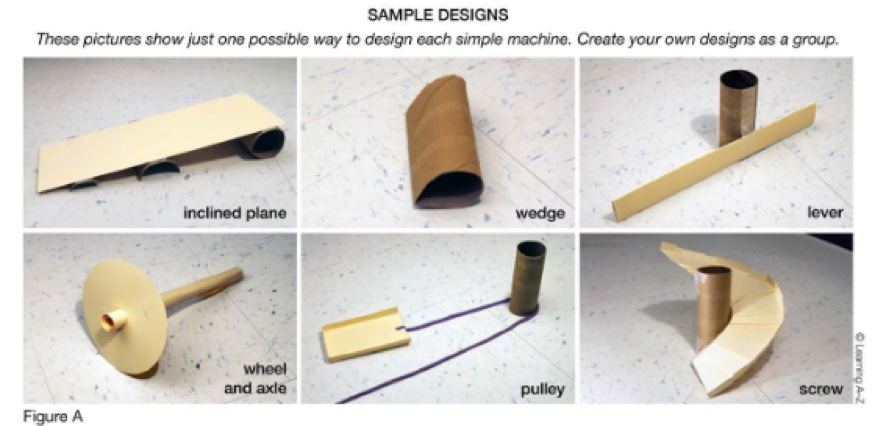In our Experience Science A-Z series, we show you what it’s like to use Science A-Z to teach science through reading and reading through science. In Part 2, we put you in the shoes of a teacher facilitating a Process Activity, a guided experiment in which students apply science and engineering practices while reading, writing, thinking, and behaving like real scientists.
Preparing to Design Machines
Before students enter class, you have already printed copies of data sheets for the students and arranged the materials: Design Machines Data Sheets 1 & 2 for each student, 12 strips of tagboard or card stock, 12 empty toilet paper rolls, scissors, yarn, roll of masking tape or clear tape, lightweight ball, and a meter stick.
When students come in, you greet them and explain that today’s activity is a hands-on extension of the Machines investigation they completed yesterday: experimenting with simple machines (inclined plane, screw, wedge, lever, wheel and axle, pulley, and gear) to design a complex machine that can make a ball travel the farthest distance.

Experiment Activities
First, you demonstrate how to build the six simple machines that students will be using in their experiment. Using the cardboard, toilet paper roll, string, masking tape, scissors, yarn and a meter stick, you model how students can assemble simple machines before they build on their own.
Then, you ask students to work in groups to build their own simple machines and test their effectiveness in making a ball move the farthest distance. As students experiment with their simple machines, remind them to record and discuss their results in Data Sheet 1.
When students have completed their simple machine experiments, you ask them to construct a complex machine from combining any three of their simple machines. Guide students in testing their complex machine’s effectiveness in moving a ball the farthest distance, and remind them to record and discuss their results in Data Sheet 2, including answering in their own words how a complex machine works.
Wrap-up and Reading Preparation
Before concluding the lesson, you ask a few students to share what they learned about how complex machines work, and you let students know to check their Kids A-Z portal for Science A-Z readings to complete by the next day. While students were designing their machines, you digitally assigned FOCUS Books to them based on their level. You found the FOCUS Books on Science A-Z under the Physical science category: The Mole Machine; Let’s Ride a Bike!; Spaceship Motions and Deep, Deep Oceans; Wrecking Ball vs. Strong Wall; and Waterwheels and Windmills.
You also let students know that they will be doing an experiment included in the “Be an Engineer” section of their digital FOCUS Book, which encourages them to apply what they learned about building their complex machine.
Stay tuned for Part 3
In part 3 you will see how Science A-Z blends independent reading practice and assessment with digital FOCUS Books.
Want to try Science A-Z in your classroom?
Get a closer look at Science A-Z’s printable, projectable, and digital STEM resources with a free trial today!


